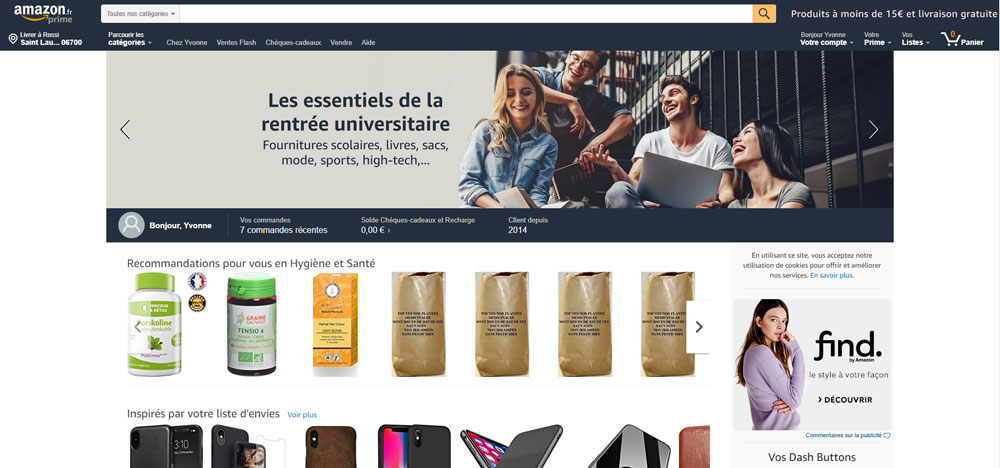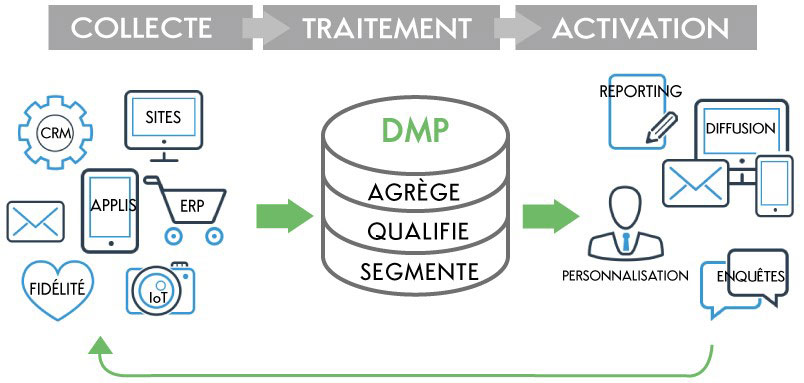Thought Leadership
How to improve the user experience with Data?
By Fabien, CRM & Data Marketing VISEO Consultant
Amazon, Google, YouTube, Facebook, Netflix... these sites are among the ones that generate the most traffic. Those that every entrepreneur dreams of copying because traffic often goes hand in hand with turnover. But then, what is the miracle recipe of these Internet giants to make the Internet user come back again and again and increase their turnover?
This article focuses on methods to improve the user experience. We will explain how to implement an effective strategy to improve the user experience through personalization, and initiate relevant customer engagement.

Amazon offers a home page where the highlighted products are personalized.
The era of personalization
The web has evolved since the first website in the 1990s when the Internet user was passive. From now on, the user buys, sells, creates content, shares... The Internet is accessible from his watch, his telephone, his headphones, his connected speaker... in other words, the Internet has become ubiquitous. To stand out from the billions of accessible sites, many elements come into play, including the user experience. This element, often neglected by platforms in favour of an acquisition budget, is the key to bring Internet users back and this is what the largest sites perfectly master: offering a unique user experience at a lower cost. This increases the Internet user's sense of consideration and brings them back. Your Netflix homepage does not look like your colleague's, and so does your Amazon homepage, Facebook, YouTube...
The essential toolbox....

To improve the user experience, it is necessary to start by setting up several tools to listen to Internet users. The first of these is a web analytics tool (such as Google Analytics). It allows you to know the page traffic and the different conversion rates. The conversion rate is not necessarily linked to a purchase act, but there must be a notion of "journey". With this question: has the Internet user succeeded in the path I propose? This can be: successfully connecting to the site, changing your shipping address, choosing a payment method, or making a purchase. Taking an interest in each route makes it possible to improve the site as a whole. The insights of the journey will also feed your reflection in the implementation of new marketing automation scenarios. It is the details that make the difference.
Then the analysis of user flows will allow to know the path taken by an Internet user to find a page in question. Since mental patterns are different from one individual to another, it is useful to analyse the flows to see if access to a page needs to be optimised.
Relying on data allows quantitative data to be extracted in order to get a first glimpse of what works and what does not.
Another tool I recommend: social networks and tools to leave an opinion on the site. Listening to users is probably the best way to know what they want. This listening to the customer makes it possible to know which elements are less clear to them, what needs to be improved or if they encounter a technical problem. This qualitative part is not insignificant and provides leads to improve UX. During a mission at a telephone operator, we used Proxem, which is a tool that allows customers to leave their opinion on the site. There is a semantic analysis of all comments, combined with user data.
Finally, the last essential tool to optimize your site: AB Tasty. The AB testing tool allows you to easily test certain functionalities, paths, wordings, design... It is also possible to combine a test with a myriad of possible customizations (Multivariate Test or MVT). Depending on the location and weather of the Internet user, you could highlight umbrellas on your site for a Lille resident, while a Nice resident would see hats to protect himself from the sun! Customization is the key to a successful UX. A/B testing tools make it possible to use the data collected by the DMP to put it at the service of UX.
...for a personalized customer experience
To go further and offer a real personalized user experience, a DMP is now essential. The DMP (Data Management Platform) is a data aggregation tool that will then allow you to reuse this data for advertising campaigns but also to improve the user experience. Installing a DMP can take time at the beginning. It is necessary to start by creating a marking plan and defining for each type of page the data to be collected. This can be the number of products in the basket, the product category, the country of residence... This marking plan will then be found in a datalayer implemented on the site by developers. Using a tag, the data will then be sent to the DMP. During a previous mission I used the combination Tag Commander and Data Commander for tag management and DMP.

Whether using AB Tasty or directly implemented on the site, you can then customize the user experience and use this data. For example, it's easy to put a greeting message with the user's first name even if the user is not logged in. If he came previously and logged in, then he can reuse this data using cookies.
A personalized experience is a win-win situation , both for the Internet user who feels considered through an optimal experience and for the brand that increases its chances of performing and satisfying its customers.


